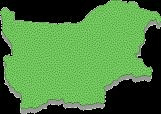|
|
Burgas region comprises the south east part of the country. The eastern border with the Black Sea ensures an opportunity for the development of tourism and shipping. The south border with Turkey is crossed by the driveway Burgas -
Tsarevo
- Malko Tarnovo - Istanbul.
The area of Burgas region is 14,724 sq. km or 13.3% of the territory of the country.
The relief is varied. Flatlands dominate while the northern and southern parts are mountainous. The climate is temperate continental and continental-Mediterranean. The wide beach strips
(Pomorie,
Burgas, Sozopol), the convenient and
scenic beautiful bays (Arapya, Nestinarka, Oazis), the characteristic dunes
(Nesebar,
Primorsko) and the salubrious climate are conductive to holiday making and recreation. Mineral water springs at Burgas,
Sliven
and in the Strandzha Mountains have made them spas. Nature reserves have been listed in the region (Rosenets, Arkutino).
The population of Burgas region is 850,000 (10.1% of the population in the country). Since 1990 it has been decreasing. The urban-rural population ratio is 68:32 (1993). Turkish-speaking population prevails in the northern part of the region along the valley of the river Luda Kamchiya.
A positive tendency is the reduction of unemployment which was 9.4% in 1993. The community network comprises by 26 towns and 465 villages. The majority of the towns along the seaside -
Nesebar,
Pomorie,
Sozopol,
Ahtopol were founded in ancient times . Old buildings with interesting architecture have been preserved and valuable archeological monuments have been found.
The economy of the region is industrial-agrarian. The region's economy is responsible for 9.5% of the employment in the country. The largest Bulgarian oil refinery Neftochim whose annual output is 12 mln tons is west of Burgas. It turns out 72% of the plastics and synthetic resins and 69% of the man-made
fibers. Sliven is the largest textile
center in the country. The carpets woven in Sliven and Kotel are internationally known. Food industry is typical for Yambol, Burgas, Karnobat, Aitos, Elhovo.
In 1992 some of the enterprises of the sector were put
forward for privatization (the sugar refinery Crystal in Kameno etc.) The natural conditions are
favorable for the development of intensive farming. The enterprise mix is: 64% cereals, 17% industrial, 3% vegetables, 16% fodder crops. The region grows 1/3 of the barley in the country (there is a regional Barley Research Institute in Karnobat), 16.4% of the fruits (apples, peaches, cherries), 15% of the sunflower. Livestock breeding is a basic
sector branch of agriculture with specialization in sheep breeding (14% of the total number of sheep in the country), cows, poultry and pig breeding.
Holiday-makers bring substantial income to the population of the region. Basic tourist
centers are Slantchev
Bryag near Nesebar, the new holiday village Eleny,
Pomorie,
Sozopol, the original architectural complex Dyuny, Primorsko, Tsarevo,
Ahtopol. The beauty and the
attractiveness of the South Black Sea coast are unique. There are nature parks and hunting farms in the Strandzha Mountains where hunting is organized.
The port of Burgas is the largest freight handler. There are special quays for loose cargo, an oil terminal, a port for timber and for livestock. Most of the raw materials for the big enterprises in the country are delivered here. The port of Burgas has an important function for the communications between the Black Sea countries and the Mediterranean. In 1989 was established a free trade zone that gives to the city a function of a transport terminal in trade links between the East and West close to the port. The fostering of market principles of management of the economy in the region necessitated the establishment of regional stock exchanges and a regional chamber of commerce and industry.
The administrative center of the region Burgas has population 196,000. Sliven and
Yambol too have coordinating functions in regional management. Burgas is an academic, financial and cultural
center with a Free University, a Chemical Engineering Institute, an Institute in Tourism.
Sliven and
Kotel have museums and collections tracing their eventful history.
|
